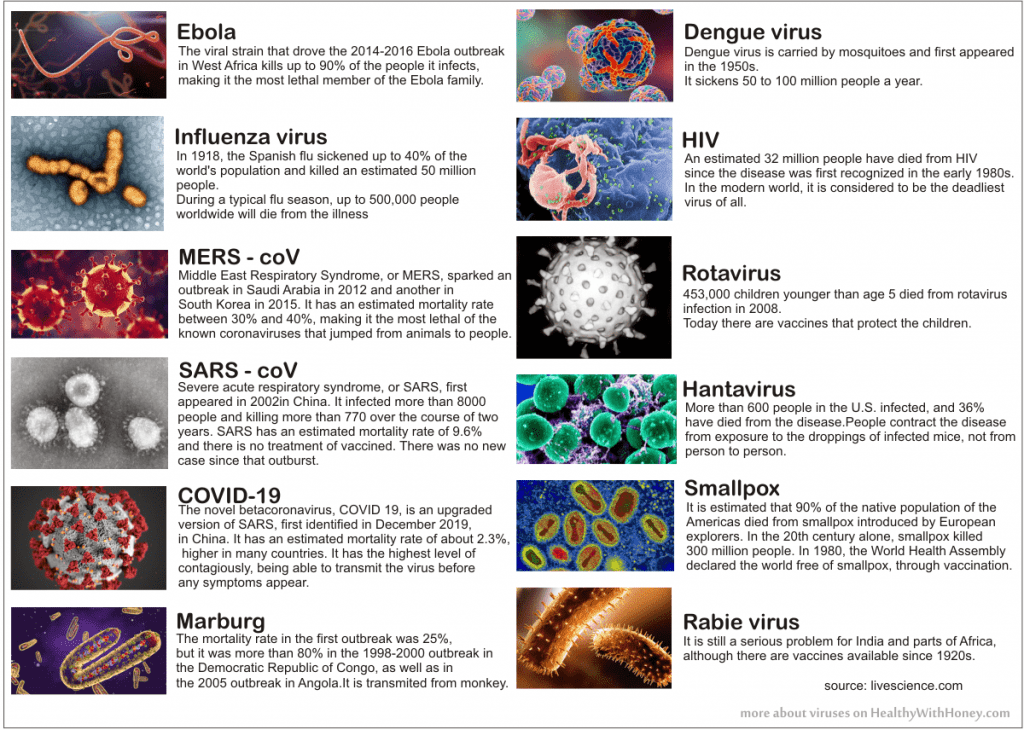The word “virus” means “poison” – and this should answer the question. The plural is viruses, although scientifically it can also be found as viri or vira.
The medical world call the virus an infectious agent. This agent is used in lack of a more specific world; it can just as well be called a thing.
And this thing is what actually rules the world, exists since life itself and is so good at that the smartest humans of today cannot outsmart it. Today they are common in people and many different species of animals, including camels, cattle, cats, and bats. Rarely, animal coronaviruses can infect people and then spread between people such as with MERS-CoV, SARS-CoV, and SARS-CoV-2 (COVID-19 is the name of the disease).
A virus is a thing that is not even a living thing. Scientists call viruses “organisms at the edge of life”, organic structures that interact with living organisms to exist. How many? Millions and millions of types… There are viruses for everything alive, from bacteria to plants, animals and humans. (The study of viruses is known as virology, a sub-specialty of microbiology.)
The best analogy can be paint. A virus is like a drop of paint. Imagine dropping water-soluble paint in the middle of some water you have on a piece of paper. The paint will spread in all the water, coloring it.
A virus does almost the same thing. Touches the cells and multiplies in all of them, poisoning and ultimately destroying them.
How does a virus look like?
Viruses are incredibly small. Their shapes range from simple helical and icosahedral to more complex structures. Most studied viruses have a diameter between 20 and 300 nanometres, which is about one-millionth of an inch. About a thousand times smaller than bacteria, and bacteria are much smaller than most human cells. An optical microscope cannot see them, so electron microscopes are used instead.
Speaking about the power of the many!
What is the structure of a virus?
A single virus particle (called a virion) has a nucleic acid (the overall name for DNA and RNA, genetic material) and an outer shell of protein (aka capsid), composed of multiple copies of one protein or a few different proteins, each of which is encoded by a single gene. In some cases a virion also has an outside envelope of lipids.
Because of this structure, a virus is able to encode all the information for making a relatively large capsid in a small number of genes. The simplest viruses contain only DNA or RNA to encode 4 proteins, but the most complex can encode up to 200 proteins.
Although they have genes, they do not have cellular structure – which is the basic unit of life. To be considered alive, a form of life will use cell division to reproduce, whereas viruses spontaneously assemble within cells.
The virus will be able to stay alive only by replicating itself, inside the living cells of an organism. Outside of it, it may have a life ranging from a few minutes to a few days.
Can we protect ourselves from the viruses?
Yes. Animals and humans have responding immune systems that usually eliminates the infecting virus. However, some of them manage to evade the immune responses and create chronic infections. It the case of HIV (that cause AIDS), HPV and viral hepatitis. For them there are antiviral drugs, that keep infections from spreading widely
An artificial acquired immunity to some viruses can also be obtain through vaccines.
Smallpox is one disease that was eradicated.
Which are the worst/deadliest viruses on Earth?
If you think COVID-19 is bad, you have missed history classes.
Ebola virus
There are many strains under this name, some more dangerous than others. it is spread through contact with blood or other body fluids, or tissue from infected people or animals.
There is one strain, Ebola Reston, that doesn’t even make people sick. But the Bundibugyo strain has a fatality rate up to 50%, and it is up to 71% for the Sudan strain.
In 1976 there was first known Ebola outbreaks in humans, striking simultaneously the Republic of the Sudan and the Democratic Republic of Congo.
The viral strain that drove the 2014-2016 Ebola outbreak in West Africa kills up to 90% of the people it infects, making it the most lethal member of the Ebola family.
HIV
“It is still the one that is the biggest killer,” said Dr. Amesh Adalja, an infectious disease physician and spokesman for the Infectious Disease Society of America. In the modern world, the deadliest virus of all may be HIV.
An estimated 32 million people have died from HIV since the disease was first recognized in the early 1980s.
Influenza
In 1918, the Spanish flu sickened up to 40% of the world’s population and killed an estimated 50 million people.
During a typical flu season, up to 500,000 people worldwide will die from the illness, according to WHO. But occasionally, when a new flu strain emerges, a pandemic results with a faster spread of disease and, often, higher mortality rates.
Dengue
Dengue virus is carried by mosquitoes and first appeared in the 1950s in the Philippines and Thailand, and has since spread throughout the tropical and subtropical regions of the globe.
Dengue sickens 50 to 100 million people a year. Although the mortality rate for dengue fever is 2.5%, lower than some other viruses, the virus can cause an Ebola-like disease called dengue hemorrhagic fever, and that condition has a mortality rate of 20% if left untreated.
SARS-CoV
Severe acute respiratory syndrome, or SARS, first appeared in 2002 in the Guangdong province of southern China. It is said it emerged in bats, then hopped into nocturnal mammals called civets, and then infected humans. From China SARS spread to 26 countries around the world, infecting more than 8000 people and killing more than 770 over the course of two years.
The disease causes fever, chills and body aches, and often progresses to pneumonia, a severe condition in which the lungs become inflamed and fill with pus. SARS has an estimated mortality rate of 9.6%, and as of yet, has no approved treatment or vaccine. There were no new cases of SARS since early 2000s.
MERS-CoV
Middle East Respiratory Syndrome, or MERS, sparked an outbreak in Saudi Arabia in 2012 and another in South Korea in 2015. The MERS virus belongs to the same family of viruses as SARS-CoV, and likely originated in bats, as well. The disease infected camels before passing into humans and triggers fever, coughing and shortness of breath in infected people.
MERS often progresses to severe pneumonia and has an estimated mortality rate between 30% and 40%, making it the most lethal of the known coronaviruses that jumped from animals to people. There are no approved treatments or vaccine.
SARS-CoV-2 aka 2019-nCoV
The novel betacoronavirus, that produces the disease called COVID 19, is an upgraded version of SARS, first identified in December 2019 in the Chinese city of Wuhan. Coming from bats, too, it has an estimated mortality rate of about 2.3%. When compared to the previous viruses, the rate is low due to our advanced medicine and medical equipment.
People who are older or have underlying health conditions seem to be most at risk of having severe disease or complications. Common symptoms include fever, dry cough and shortness of breath, and the disease can progress to pneumonia in severe cases.
Marburg virus
In 1967 lab workers from Germany, who were exposed to infected monkeys imported from Uganda, developed a viral outbreak caused by Marburg virus. It’s a terrible virus that resembles Ebola, causing infected people to develop high fevers and bleeding throughout the body, leading to shock, organ failure and death.
The mortality rate in the first outbreak was 25%, but it was more than 80% in the 1998-2000 outbreak in the Democratic Republic of Congo, as well as in the 2005 outbreak in Angola, according to the World Health Organization (WHO).
Rotavirus
Attacking the digestive system, rotavirus is the leading cause of severe diarrheal illness among babies and young childrenis. The virus can spread rapidly through the fecal-oral route (meaning that small particles of feces end up being consumed). There are two vaccines now available to protect children from rotavirus.
The WHO estimates that worldwide, 453,000 children younger than age 5 died from rotavirus infection in 2008.
Rabies
Rabies is still a serious problem for India and parts of Africa, although it is now extremely rare in the developed countries. There are rabies vaccines for pets, introduced since the 1920s, and if someone gets bitten that person can be treated. Otherwise there is 100% possibilities to die.
Hantavirus
Hantavirus pulmonary syndrome (HPS) first gained wide attention in the U.S. in 1993, when a healthy, young Navajo man and his fiancée living in the Four Corners area of the United States died within days of developing shortness of breath. A few months later, health authorities isolated hantavirus from a deer mouse living in the home of one of the infected people.
More than 600 people in the U.S. have now contracted HPS, and 36% have died from the disease, according to the Centers for Disease Control and Prevention. The virus is not transmitted from one person to another, rather, people contract the disease from exposure to the droppings of infected mice.
Smallpox
In 1980, the World Health Assembly declared the world free of smallpox. But before that, humans battled smallpox for thousands of years, and the disease killed about 1 in 3 of those it infected. It left survivors with deep, permanent scars and, often, blindness.
It is estimated that 90% of the native population of the Americas died from smallpox introduced by European explorers. In the 20th century alone, smallpox killed 300 million people.
Why are children less affected by coronavirus?
This is another mystery scientists have yet to solve. It happened with chickenpox and measles, SARS and MERS and is happening now in COVID-19. Children get infected too, but they have easier symptoms.
Some say they have a more robust immune system and the disease doesn’t lay them out, the way it would as an adult. For some reasons they escape from the worst effects of the virus.
Adults are 25 times more likely to die from chickenpox than children are. Seasonal flu death rates in adults are 10 times that of death rates in children. Influenza can be devastating for infants, yet older children usually make it through with more ease than adults.
Here are 3 reasons given by scientists:
1. Children’s innate immune system;
2. A much healthier respiratory tract, which was less exposed to cigarette smoke and pollution;
3. Lack of other chronic health conditions. These conditions could include anything from diabetes to autoimmune disorders to cardiovascular disease, respiratory disease or even simple obesity.
What’s the treatment for coronaviruses?
There is no agreement on a valid, clinically approved medical treatment, nor vaccine. Through observation it was confirmed that the treatment with methylprednisolone may be beneficial for patients who develop acute respiratory disease syndrome.
Mild cases (which are nevertheless worse than flu) are to be treated only with paracetamol, no ibuprofen – as this one seemed to worsen the symptoms. When the cases are severe, this also means powerful antiinflammatory drugs and you need intensive care in hospitals. There is no joke here.
In China, the latest version of the Diagnosis and Treatment of Pneumonia Caused by COVID‐19, issued by the National Health Commission of the People’s Republic, recommended a combination of lopinavir and ribavirin (LPV/r). The antiviral activity of LPV/r is similar to that of LPV alone, suggesting that the effect is largely driven by LPV – a protease inhibitor. (source).
However, during the treatment period, there are serious adverse reactions that need to be taken into consideration: diarrhea, nausea, and asthenia. Elevated total bilirubin, triglyceride, and hepatic enzyme levels have also been reported.
Chinese used this treatment based on the experience accumulated from the SARS and MERS outbreaks. The treatment of CoV patients with LPV/r improved their outcomes.
There are many other ongoing clinical trials, with other drugs, so for us it is better to trust scientists and patiently wait. It’s not like we can buy these drugs OTC anyway.
Is there a natural treatment for coronavirus?
China also used traditional medicine to heal its people. At least those who were having milder forms and were quarantined. Here you can find what to take for each symptom. Yet, their remedies only ease the symptoms, they do not kill the virus. If they had, be sure they would not have so many deaths.
For the moment, until further clinical studies, the only natural treatments for coronaviruses are to be found in the same category as other antivirals. Here is a list with the most important (and studied) of them: How to fight flu naturally.
Among them: quercetin, propolis, manuka honey, curcumin, olive leaf, black seeds, essential oils, echinacea, onion and honey.
BEWARE of pretenders and frauds! Companies are making Coronavirus claims which are only claims, nothing more, in a shameful effort of making more money. Please consult the list here: FTC, FDA warn companies making Coronavirus claims.
For accurate information please inform yourself from CDC website.
If you want to know the latest research information from National Institutes of Health (NIH) please see: https://www.nih.gov/coronavirus
How to strengthen our immune system?
Here is a set of recommendations made by Harvard Medical School and available on https://www.health.harvard.edu/diseases-and-conditions/coronavirus-resource-center. Apply them in your life, make them your lifestyle and be ready to confront any type of virus.
Viruses and cancer
I bet you didn’t know that. Cancer can be triggered by viruses, although only in a minority of infected persons (or animals). Cancer viruses come from a range of virus families, including both RNA and DNA viruses, and so there is no single type of “oncovirus”. The development of cancer is determined by a variety of factors such as host immunity and mutations in the host.
Viruses accepted to cause human cancers include some genotypes of human papillomavirus, hepatitis B virus, hepatitis C virus, Epstein–Barr virus, Kaposi’s sarcoma-associated herpesvirus and human T-lymphotropic virus.
References:
https://www.ncbi.nlm.nih.gov/books/NBK21523/
https://www.cdc.gov/coronavirus/2019-ncov/cases-updates/summary.html
https://www.livescience.com/why-kids-missing-coronavirus-cases.html
https://www.livescience.com/56598-deadliest-viruses-on-earth.html
https://en.wikipedia.org/wiki/Virus
https://www.health.harvard.edu/diseases-and-conditions/coronavirus-resource-center





